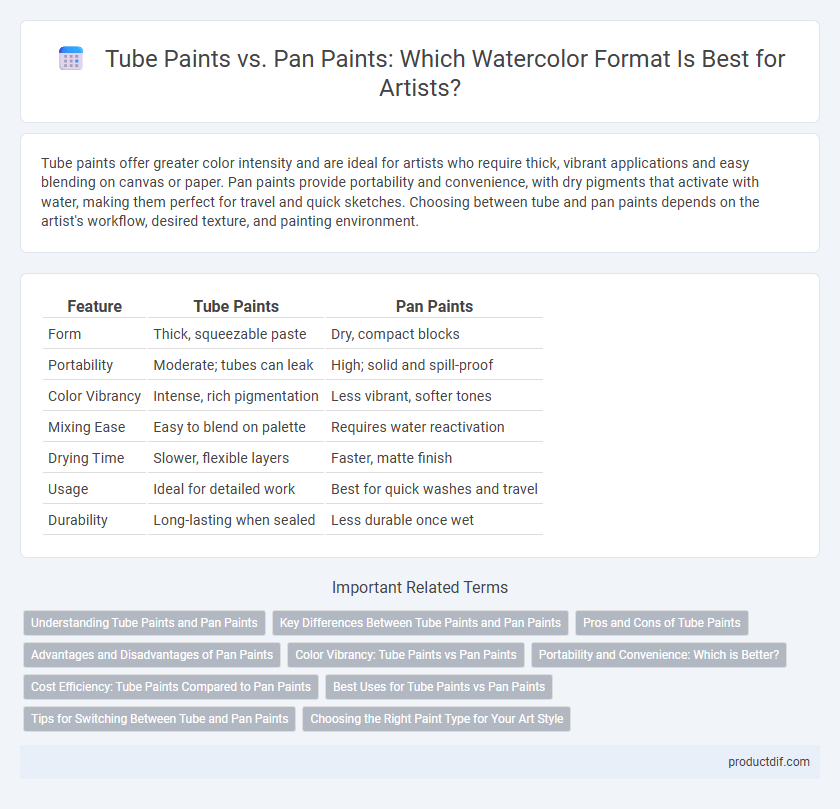Tube paints offer greater color intensity and are ideal for artists who require thick, vibrant applications and easy blending on canvas or paper. Pan paints provide portability and convenience, with dry pigments that activate with water, making them perfect for travel and quick sketches. Choosing between tube and pan paints depends on the artist's workflow, desired texture, and painting environment.
Table of Comparison
| Feature | Tube Paints | Pan Paints |
|---|---|---|
| Form | Thick, squeezable paste | Dry, compact blocks |
| Portability | Moderate; tubes can leak | High; solid and spill-proof |
| Color Vibrancy | Intense, rich pigmentation | Less vibrant, softer tones |
| Mixing Ease | Easy to blend on palette | Requires water reactivation |
| Drying Time | Slower, flexible layers | Faster, matte finish |
| Usage | Ideal for detailed work | Best for quick washes and travel |
| Durability | Long-lasting when sealed | Less durable once wet |
Understanding Tube Paints and Pan Paints
Tube paints offer artists vibrant, highly pigmented colors with excellent consistency and moisture retention, making them ideal for creating rich, textured artworks. Pan paints, commonly used in watercolor sets, provide convenience and portability with pre-dried pigment that activates with water, ensuring controlled washes and easy layering. Understanding the properties of tube paints and pan paints helps artists select the right medium for their technique and desired visual effects.
Key Differences Between Tube Paints and Pan Paints
Tube paints offer higher pigment concentration and smoother application, making them ideal for detailed work and mixing, while pan paints provide convenience and portability with pre-dried, solid formats suited for quick washes and travel. Tube paints typically contain more binder and moisture, resulting in richer color intensity and longer drying times compared to the compact, fast-drying pan paints. Artists choose tube paints for vibrant, customizable palettes and pan paints for ease of use and minimal mess.
Pros and Cons of Tube Paints
Tube paints offer superior color intensity and longer shelf life compared to pan paints, making them ideal for artists seeking vibrant, durable pigments. Their airtight packaging prevents drying out, allowing for gradual usage and excellent preservation of paint quality. However, tube paints can be less portable and more susceptible to waste if excess paint is squeezed out, unlike the compact and convenient nature of pan paints.
Advantages and Disadvantages of Pan Paints
Pan paints offer superior portability and convenience, making them ideal for artists who paint outdoors or on the go. However, their limited color mixing flexibility and smaller pigment concentration can hinder the creation of custom hues compared to tube paints. The ease of use and mess-free application is balanced by reduced intensity and less versatility in blending.
Color Vibrancy: Tube Paints vs Pan Paints
Tube paints offer richer color vibrancy due to their higher pigment concentration and thicker consistency, allowing artists to achieve intense, saturated hues. Pan paints tend to be more diluted, resulting in softer, less vibrant colors but greater ease in blending and layering. For projects demanding bold, vivid results, tube paints provide superior color payoff compared to pan paints.
Portability and Convenience: Which is Better?
Tube paints offer superior portability for artists on the go, allowing easy transport without the mess or drying issues common with pan paints. Their airtight packaging preserves paint quality, making them ideal for outdoor painting sessions and quick touch-ups. Conversely, pan paints are compact and organized, but may require water and separate mixing surfaces, reducing convenience during travel.
Cost Efficiency: Tube Paints Compared to Pan Paints
Tube paints deliver higher pigment concentration and longer shelf life, offering better value per use despite a higher upfront cost. Pan paints tend to be more affordable initially but may require frequent replacement due to limited quantities and potential drying issues. Investing in tube paints often results in greater cost efficiency for artists seeking durability and richer color payoff.
Best Uses for Tube Paints vs Pan Paints
Tube paints offer rich pigmentation and superior blendability, making them ideal for detailed work, layering, and mixing custom colors in fine art and professional painting. Pan paints provide convenience and portability, suitable for quick sketches, travel, and watercolor techniques requiring minimal mess and easy access. Artists select tube paints for vibrant, dense application, while pan paints excel in compactness and ease of use for on-the-go creativity.
Tips for Switching Between Tube and Pan Paints
When transitioning between tube paints and pan paints, always test color saturation on a separate palette to adjust water ratios and brush loading for consistent vibrancy. Clean brushes thoroughly when switching types to avoid pigment contamination and maintain paint purity. Store tube paints tightly sealed to prevent drying, while pan paints benefit from a damp brush technique to revive hardness and enhance pigment flow.
Choosing the Right Paint Type for Your Art Style
Tube paints offer vibrant, highly pigmented colors ideal for artists who prefer thick, textured applications and blending on canvas, while pan paints provide convenience and portability suitable for quick sketches, travel, and watercolors with controlled washes. For intensive layering and mixing, acrylic and oil tube paints deliver superior consistency and durability, whereas pan paints, often used by watercolorists and urban sketchers, enable precise control and ease of use on the go. Selecting tube or pan paints depends on your preferred medium, painting technique, and whether portability or color intensity is your priority.
Tube Paints vs Pan Paints Infographic

 productdif.com
productdif.com